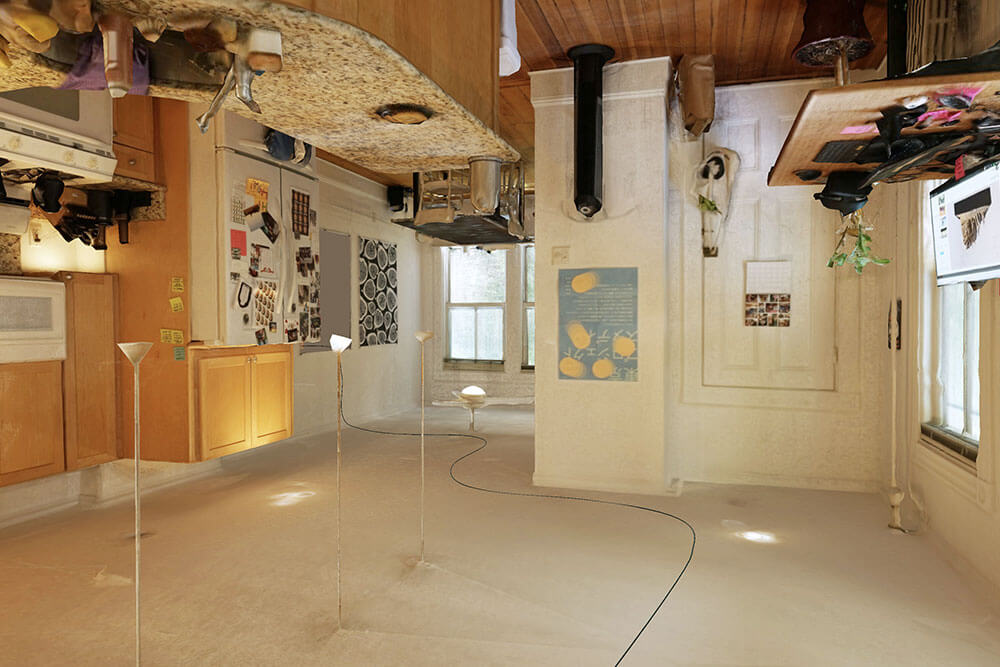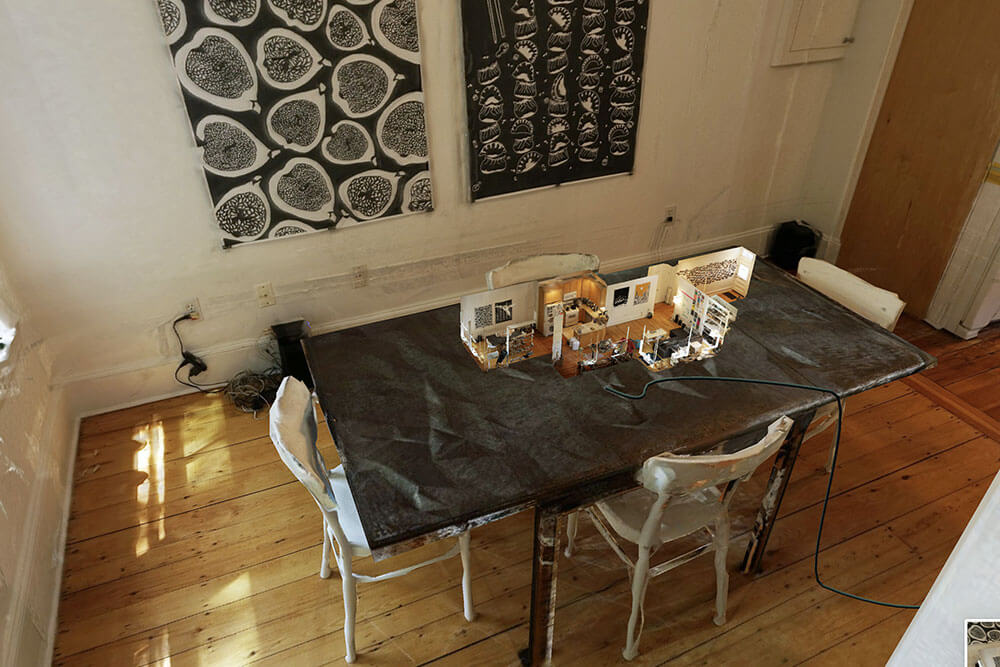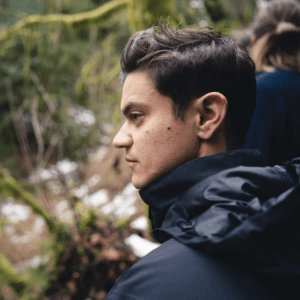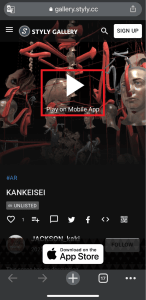This article introduces Wyatt Roy’s VR work Piece of String, a NEWVIEW AWARD 2019 finalist and winner of the SILVER Award and MEDIA AMBITION TOKYO PRIZE. Instructions on how to view the work are provided at the end of the article.
A room scanned with photogrammetry
Piece of String is a photogrammetric VR work by creative director Wyatt Roy. Photogrammetry is technology that generates a 3D model by capturing objects and spaces from various angles and allows photographs to become three-dimensional. Using this technology, the artist’s actual home is replicated in the VR world for Piece of String.
The rooms here are different from most Japanese homes and have a distinctly Western feel. As the scene starts, viewers enter the house without even ringing the doorbell to find no one there. What do we—as sudden visitors—see in this empty room?
Artist’s commentary:
One second after you throw a pebble into a lake, the pebble has disappeared and only the ripples remain. What does a home feel like after the people who live there disappear, and only their echoes remain?
(Cited from theNEWVIEW official website)
As we follow the cable on the floor…
The chirping of birds echo through this obviously habited house, and we perceive that we must be somewhere close to nature. The desk looks like someone was just working there, and on it is a mouse with a very long cable. We suspect that the mouse is connected to the computer, but the cable seems to be hanging loose on the floor. What exactly is at the end of this cable?
Following this cable is the highlight of this work.
The cable runs from the dining room to the kitchen. It stretches around every corner of the room as if to frame the floor plan of this house, and it continues through the living room to the hallway.
The cable runs from the dining room to the kitchen. It stretches around every corner of the room as if to frame the floor plan of this house, and it continues through the living room to the hallway.
Following the cable through the wall, we end up in a room that is upside down. It looks identical to the room that we were in earlier; now upside down, however, it looks like a completely different space. We walk along the ceiling and follow the cable further.
Exploring the upside-down room, we end up in a space where everything is back to normal.
Then, we arrive at a desk in one of the rooms. On the desk is a replica of the same space we are in now. The cable leads to a smaller room in the replica.
If you follow the cable inside the replica, we reach the same room again. We see the same desk, and on that desk there is another replica. It is obvious that smaller and smaller rooms are connected in an infinite loop.
About the Artist
Wyatt Roy
Creative Director | United States
Wyatt is a writer, photographer, filmmaker, and virtual reality artist who researches new ways to create and share immersive stories. His VR narratives focus on capturing and communicating nuanced human characters, the spaces in which we live, and the emotions embedded in our memories. He is a co-founder of Maku, a film and photography creative collective, and holds a Bachelor of Arts in Psychology from Stanford.
(Cited from the NEWVIEW official website)
Space and memory, reality and fiction
A moment of reality captured in a photo of a living space and a 3D model created out of it. When this moment is preserved in the virtual space of VR, it will never fade or age.
A computer in the middle of work, a refrigerator with underwear tossed over it, post-its, and photos of special moments covering the wall. The faint presence of life in the room gives the illusion that this space is real. However, as if to betray this illusion, the room itself becomes smaller and smaller as it is turned upside down, and the space continues to change over and over again. Isn’t this reminiscent of our memory?
The Method of loci (also known as the memory palace) is an ancient Greek memorization technique. You imagine a room and place the things they would like to remember in this imaginary space. For example, if a person wants to memorize a “Pomeranian dog”, they would imagine a Pomeranian lying on a cushion placed on a Persian carpet in the room. With this, they are able to extract this memory in the future from the impressions they have and the placement of things in the room. This technique is embracing our strength in remembering spatial relationships, and such memories are said to be easier to extract from the brain.
From this perspective, space and memory are closely related, and one might say that space is memory itself. However, human memory is ambiguous, and even when we think we remember something clearly, it is often subjective, and as time passes it becomes far removed from objective facts. This work turns the viewer’s first impression of the space upside down through the experience of walking around the form-changing room and repeatedly changes the memory of the impression of the room itself. One way to enjoy this work is to savor the ambiguity of such memories, new perspectives, and the sense that things are not quite as they seem.
Architect Keisuke Toyoda, a member of the NEWVIEW AWARD 2019 jury, commented on the work as follows:
I feel the artistic possibility that a very common room is guided through a casual act of following the cable to re-examine the spatial relationship and scale, the existence of the environment of the room, and the existence of the self again. It made me feel once again that VR media is suitable for the act of extracting and editing meaning, where reality creates fiction, and fiction reconstructs and redefines the meaning of reality.
(Cited from the NEWVIEW official website)
A space that repeats and continues while changing its form. The poetic reverberations that flow in this space may encompass something not of a tangible form; this something that is perceived in this virtual space could perhaps be a sensation beyond the five senses of the body.
We invite you to experience the new recollections that are echoed in this virtual space.
How to experience a VR scene
If you are accessing this page from a smartphone, please click on the “Experience the Scene” button (*If you are experiencing the scene on a smartphone for the first time, please also refer to the following instructions).
After clicking, the following screen will be displayed.
If you have already downloaded the STYLY Mobile app, please select “Continue on Browser”.
You can then select “Play on Mobile App” to experience the scene.
If you have an HMD device, click the “Experience the Scene” button from your PC (web browser), then click the VR icon on the scene page.
Download the STYLY Mobile app
Download the Steam version of STYLY app
https://store.steampowered.com/app/693990/STYLYVR_PLATFORM_FOR_ULTRA_EXPERIENCE/
Download the Oculus Quest version of STYLY app
https://www.oculus.com/experiences/quest/3982198145147898/
For those who want to know more about how to experience the scene
For more information on how to experience VR scenes, please refer to the following article.
Edited by SASAnishiki
Translated by cpnnn











![[Summary] How to experience STYLY scenes VR/AR(Mobile) / Web Browser Introduction by step](https://styly.cc/wp-content/uploads/2020/04/スクリーンショット-2020-04-10-12.53.04-160x160.png)